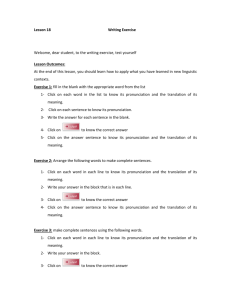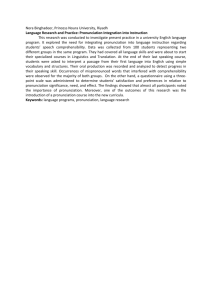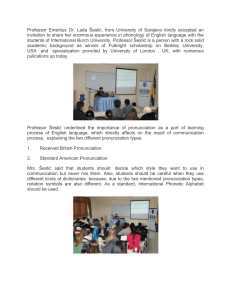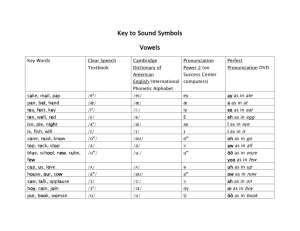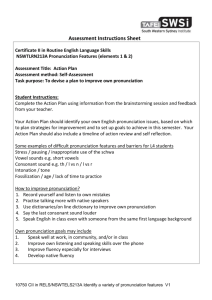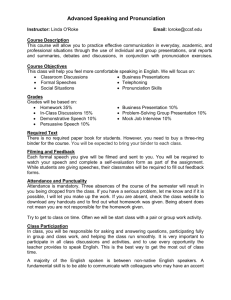Lesson explanation
advertisement
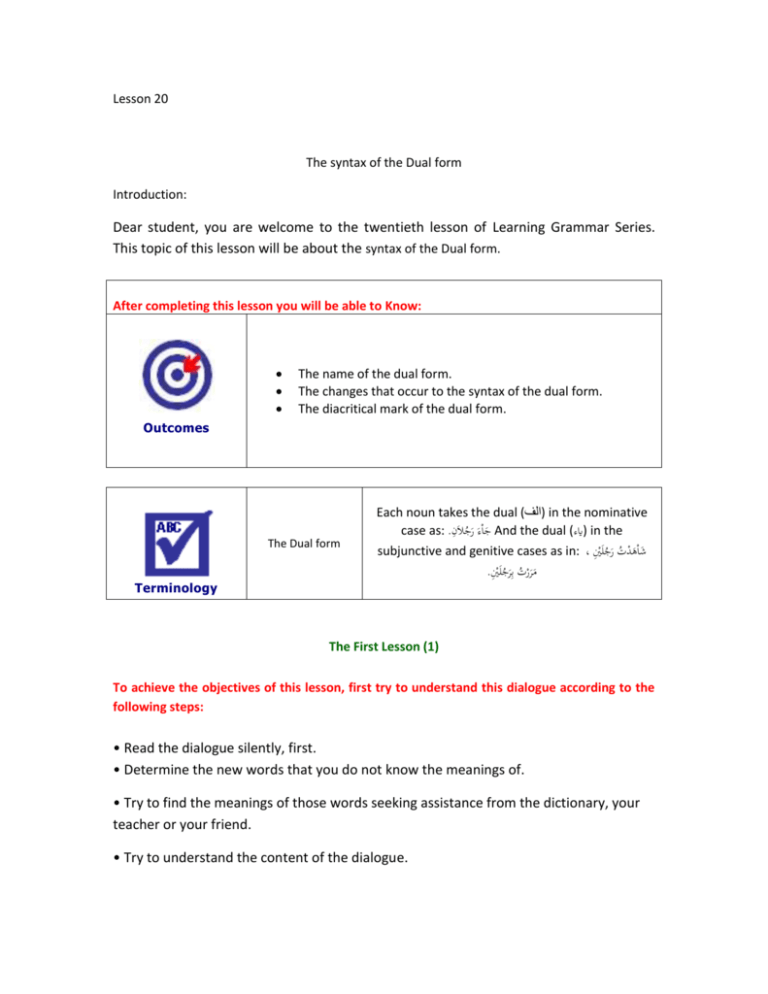
Lesson 20 The syntax of the Dual form Introduction: Dear student, you are welcome to the twentieth lesson of Learning Grammar Series. This topic of this lesson will be about the syntax of the Dual form. After completing this lesson you will be able to Know: The name of the dual form. The changes that occur to the syntax of the dual form. The diacritical mark of the dual form. Outcomes The Dual form Terminology Each noun takes the dual ( )الفin the nominative case as: . َجاْءَ َر ُجالَ ِنAnd the dual ( )ايءin the ِ ْ َت ر ُجل subjunctive and genitive cases as in: ، ْي َ ُ َشاْ َه ْد ِ ْ َت بِر ُجل .ْي َ ُ َمَرْر The First Lesson (1) To achieve the objectives of this lesson, first try to understand this dialogue according to the following steps: • Read the dialogue silently, first. • Determine the new words that you do not know the meanings of. • Try to find the meanings of those words seeking assistance from the dictionary, your teacher or your friend. • Try to understand the content of the dialogue. • To understand the content of the dialogue, click on the “listen” icon and listen carefully, then look at the translation. • Practice this dialogue with your neighbor. • Contact your friend using the available means of communication, and then practice this dialogue with him/her. Comprehension Questions Exercise 1 2 • Click on each question to know its pronunciation and the translation of its meaning. • Write the answer. • Click on to know the answer. • Click on the answer sentence to know its pronunciation and the translation of its meaning. Lesson explanation Go back to the dialogue once again and look closely at the words written in the blue color. All the nouns written in blue color in the previous examples are in the dual form, but if you look closely at these nouns once again you will find that some of them are in the singular form and (ْ )أَنis added to the singular form which refers that they are in the indicative mood. Some others were added ( )يَنto their singular form which refers that they are in the subjunctive or genitive mood. This is to indicate that the dual form is being nominative with ( )الفand subjunctive and genitive with ( )ياءproceeded by a letter takes on diacritical mark the fatha. Summary: The dual is each noun takes the dual ( )الفin the nominative case and the dual ( )ايءin the subjunctive and genitive cases. Exercise 2 3 Click on each sentence to learn its pronunciation and to know the translation of its meaning. Notice the diacritical mark of the singular and dual in the subjunctive, nominative and genitive cases. Exercise 3 4 Click on each sentence to to learn its pronunciation and to know the translation of its meaning. Write the answer in the block. Click on Click on the answer sentence to learn its pronunciation and to know the translation of to know the correct answer. its meaning. Write the answer in the homework notebook. Exercise 4 5 Click on each question to learn its pronunciation and to know the translation of its meaning. Write the answer. Click on Click on the answer sentence to learn its pronunciation and to know the translation of to know the correct answer. its meaning. Write the answer in the homework notebook. Exercise 5 6 Click on each question to know its pronunciation and the translation of its meaning. Write the answer. Click on Click on the answer sentence to know its pronunciation and the translation of its to know the correct answer. meaning. Write these sentences in the homework notebook. Exercise 5 6 Click on each sentence to know its pronunciation and the translation of its meaning. Write the answer in the block. Click on Click on the answer sentence to know its pronunciation and the translation of its to know the correct answer. meaning. Write these sentences in the homework notebook. Look at the dual form mark. Exercise 7 8 Click on each word to know its pronunciation and the translation of its meaning. Write the answer in the block. Click on Click on the answer sentence to know its pronunciation and the translation of its to know the correct answer. meaning. Exercise 8 9 The words ( )احدمهاand ( )االخرhave many different meanings according to the context. Click on each sentence to know its pronunciation and the translation of its meaning. Write these sentences in the homework notebook. Exercise 9 10 The words ( )احدامهاand ( )االخرhave many meanings in the female form differ according to the context. To look closely at the meaning, Click on each sentence to know its pronunciation and the translation of its meaning. Write these sentences in the homework notebook. Exercise 10 11 The word ( )ذُوis used for the singular male, it means (owner) The word ( ) َذاتis used for the singular female, it means (owner) To look closely at the meaning, click on each sentence to learn its pronunciation and to know the translation of its meaning. Write these sentences in the homework notebook. Exercise 11 New Vocabulary Click on each word to know its pronunciation and the translation of its meaning. Repeat the pronunciation of each word three times. Write these sentences in the homework notebook. With the help of ALLAH, the twentieth lesson is completed. Goodbye and see you in the twenty first lesson in which you will study the genitive Case of the present tense verb with the particles ) (ملand )(ملا
